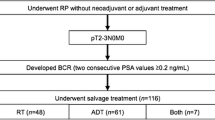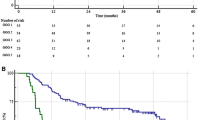Abstract
Purpose
Oncologic outcomes of patients with pT3aN0/Nx prostate cancer (PCa) with positive surgical margins (PSM) after radical prostatectomy (RP) are heterogeneous. We investigated the impact of Gleason score (GS) on biochemical recurrence (BCR) in these patients.
Methods
A retrospective, multicenter study was performed on 795 patients with pT3aN0/Nx PCa with PSM after RP between January 2006 and December 2014. Clinicopathologic characteristics of patients were examined and onset of BCR was identified. Kaplan–Meier survival analysis was used to illustrate BCR-free survival (BFS) and Cox proportional hazard models were applied to identify factors predicting BCR.
Results
During the mean follow-up period of 63.9 months, BCR was identified in 274 (34.5%) patients. The 5-year BFS was 56.6% in all patients. In multivariate analysis, pathologic GS was the only significant prognostic factor for BCR in patients with pT3aN0/Nx PCa with PSM (GS 6 vs. GS 7 (3 + 4), P = 0.047; vs. GS 7 (4 + 3), P = 0.007, and vs. GS 8–10, P < 0.001). When patients were stratified according to GS, 5-year BFS was 78.6% in GS 6, 66.2% in GS 7 (3 + 4), 51.1% in GS 7 (4 + 3) and 35.5% in GS 8–10.
Conclusions
In patients with pT3aN0/Nx with PSM after RP, pathologic GS is the sole independent predictor for risk stratification of BCR. These findings might be used to determine the risk and timing of BCR and to help counsel patients regarding treatment strategy and prognosis of disease on an individual basis.


Similar content being viewed by others
References
Abdollah F, Suardi N, Cozzarini C, Gallina A, Capitanio U, Bianchi M, Sun M, Fossati N, Passoni NM, Fiorino C, Di Muzio N, Karakiewicz PI, Rigatti P, Montorsi F, Briganti A (2013) Selecting the optimal candidate for adjuvant radiotherapy after radical prostatectomy for prostate cancer: a long-term survival analysis. Eur Urol 63:998–1008
Bianco FJ Jr, Scardino PT, Eastham JA (2005) Radical prostatectomy: long-term cancer control and recovery of sexual and urinary function (“trifecta”). Urology 66:83–94
Bolla M, van Poppel H, Collette L, van Cangh P, Vekemans K, Da Pozzo L, de Reijke TM, Verbaeys A, Bosset JF, van Velthoven R, Marechal JM, Scalliet P, Haustermans K, Pierart M, European Organization for R, Treatment of C (2005) Postoperative radiotherapy after radical prostatectomy: a randomised controlled trial (EORTC trial 22911). Lancet 366:572–578
Cao D, Kibel AS, Gao F, Tao Y, Humphrey PA (2010) The Gleason score of tumor at the margin in radical prostatectomy is predictive of biochemical recurrence. Am J Surg Pathol 34:994–1001
Chun FK, Graefen M, Zacharias M, Haese A, Steuber T, Schlomm T, Walz J, Karakiewicz PI, Huland H (2006) Anatomic radical retropubic prostatectomy-long-term recurrence-free survival rates for localized prostate cancer. World J Urol 24:273–280
D’Amico AV, Cote K, Loffredo M, Renshaw AA, Schultz D (2002) Determinants of prostate cancer-specific survival after radiation therapy for patients with clinically localized prostate cancer. J Clin Oncol 20:4567–4573
Epstein JI (2010) An update of the Gleason grading system. J Urol 183:433–440
Gandaglia G, Karakiewicz PI, Briganti A, Trudeau V, Trinh QD, Kim SP, Montorsi F, Nguyen PL, Abdollah F, Sun M (2015) Early radiotherapy after radical prostatectomy improves cancer-specific survival only in patients with highly aggressive prostate cancer: validation of recently released criteria. Int J Urol 22:89–95
Han M, Partin AW, Pound CR, Epstein JI, Walsh PC (2001) Long-term biochemical disease-free and cancer-specific survival following anatomic radical retropubic prostatectomy. The 15-year Johns Hopkins experience. Urol Clin N Am 28:555–565
Heidenreich A, Bellmunt J, Bolla M, Joniau S, Mason M, Matveev V, Mottet N, Schmid HP, van der Kwast T, Wiegel T, Zattoni F, European Association of U (2011) EAU guidelines on prostate cancer. Part 1: screening, diagnosis, and treatment of clinically localised disease. Eur Urol 59:61–71
Heidenreich A, Bastian PJ, Bellmunt J, Bolla M, Joniau S, van der Kwast T, Mason M, Matveev V, Wiegel T, Zattoni F, Mottet N, European Association of U (2014) EAU guidelines on prostate cancer. Part II: treatment of advanced, relapsing, and castration-resistant prostate cancer. Eur Urol 65:467–479
Hull GW, Rabbani F, Abbas F, Wheeler TM, Kattan MW, Scardino PT (2002) Cancer control with radical prostatectomy alone in 1,000 consecutive patients. J Urol 167:528–534
Karl A, Buchner A, Tympner C, Kirchner T, Ganswindt U, Belka C, Ganzer R, Wieland W, Eder F, Hofstadter F, Schilling D, Sievert KD, Stenzl A, Scharpf M, Fend F, Vom Dorp F, Rubben H, Schmid KW, Porres-Knoblauch D, Heidenreich A, Hangarter B, Knuchel-Clarke R, Rogenhofer M, Wullich B, Hartmann A, Comploj E, Pycha A, Hanspeter E, Pehrke D, Sauter G, Graefen M, Gratzke C, Stief C, Wiegel T, Haese A (2015) Risk and timing of biochemical recurrence in pT3aN0/Nx prostate cancer with positive surgical margin—a multicenter study. Radiother Oncol 116:119–124
Mian BM, Troncoso P, Okihara K, Bhadkamkar V, Johnston D, Reyes AO, Babaian RJ (2002) Outcome of patients with Gleason score 8 or higher prostate cancer following radical prostatectomy alone. J Urol 167:1675–1680
Roehl KA, Han M, Ramos CG, Antenor JA, Catalona WJ (2004) Cancer progression and survival rates following anatomical radical retropubic prostatectomy in 3,478 consecutive patients: long-term results. J Urol 172:910–914
Song W, Kwon YS, Jeon SS, Kim IY (2017) Refining the American Urological Association and American Society for Radiation Oncology guideline for adjuvant radiotherapy after radical prostatectomy using the pathologic Gleason score. Asian J Androl 19:20–25
Srigley JR, Humphrey PA, Amin MB, Chang SS, Egevad L, Epstein JI, Grignon DJ, McKiernan JM, Montironi R, Renshaw AA, Reuter VE, Wheeler TM, Members of the Cancer Committee CoAP (2009) Protocol for the examination of specimens from patients with carcinoma of the prostate gland. Arch Pathol Lab Med 133:1568–1576
Stephenson AJ, Scardino PT, Eastham JA, Bianco FJ Jr, Dotan ZA, DiBlasio CJ, Reuther A, Klein EA, Kattan MW (2005) Postoperative nomogram predicting the 10-year probability of prostate cancer recurrence after radical prostatectomy. J Clin Oncol 23:7005–7012
Stephenson AJ, Wood DP, Kattan MW, Klein EA, Scardino PT, Eastham JA, Carver BS (2009) Location, extent and number of positive surgical margins do not improve accuracy of predicting prostate cancer recurrence after radical prostatectomy. J Urol 182:1357–1363
Suardi N, Porter CR, Reuther AM, Walz J, Kodama K, Gibbons RP, Correa R, Montorsi F, Graefen M, Huland H, Klein EA, Karakiewicz PI (2008) A nomogram predicting long-term biochemical recurrence after radical prostatectomy. Cancer 112:1254–1263
Swanson GP, Riggs M, Hermans M (2007) Pathologic findings at radical prostatectomy: risk factors for failure and death. Urol Oncol 25:110–114
Thompson IM Jr, Tangen CM, Paradelo J, Lucia MS, Miller G, Troyer D, Messing E, Forman J, Chin J, Swanson G, Canby-Hagino E, Crawford ED (2006) Adjuvant radiotherapy for pathologically advanced prostate cancer: a randomized clinical trial. JAMA 296:2329–2335
Thompson IM, Valicenti RK, Albertsen P, Davis BJ, Goldenberg SL, Hahn C, Klein E, Michalski J, Roach M, Sartor O, Wolf JS Jr, Faraday MM (2013) Adjuvant and salvage radiotherapy after prostatectomy: AUA/ASTRO guideline. J Urol 190:441–449
Udo K, Cronin AM, Carlino LJ, Savage CJ, Maschino AC, Al-Ahmadie HA, Gopalan A, Tickoo SK, Scardino PT, Eastham JA, Reuter VE, Fine SW (2013) Prognostic impact of subclassification of radical prostatectomy positive margins by linear extent and Gleason grade. J Urol 189:1302–1307
Wiegel T, Bottke D, Steiner U, Siegmann A, Golz R, Storkel S, Willich N, Semjonow A, Souchon R, Stockle M, Rube C, Weissbach L, Althaus P, Rebmann U, Kalble T, Feldmann HJ, Wirth M, Hinke A, Hinkelbein W, Miller K (2009) Phase III postoperative adjuvant radiotherapy after radical prostatectomy compared with radical prostatectomy alone in pT3 prostate cancer with postoperative undetectable prostate-specific antigen: ARO 96-02/AUO AP 09/95. J Clin Oncol 27:2924–2930
Acknowledgements
This study was performed by the Prostate Cancer Research Committee of the Korean Urological Oncology Society.
Author information
Authors and Affiliations
Corresponding authors
Ethics declarations
Conflict of interest
The authors declare that they have no conflict of interest.
Ethical approval
All procedures performed in studies involving human participants were in accordance with the ethical standards of the institutional and/or national research committee and with the 1964 Helsinki declaration and its later amendments or comparable ethical standards.
Funding
No funding was received.
Informed consent
Written informed consent was exempted because of the retrospective study design.
Rights and permissions
About this article
Cite this article
Song, W., Lee, D.H., Jeon, H.G. et al. Impact of Gleason score on biochemical recurrence in patients with pT3aN0/Nx prostate cancer with positive surgical margins: a multicenter study from the Prostate Cancer Research Committee. J Cancer Res Clin Oncol 143, 2393–2400 (2017). https://doi.org/10.1007/s00432-017-2502-7
Received:
Accepted:
Published:
Issue Date:
DOI: https://doi.org/10.1007/s00432-017-2502-7




